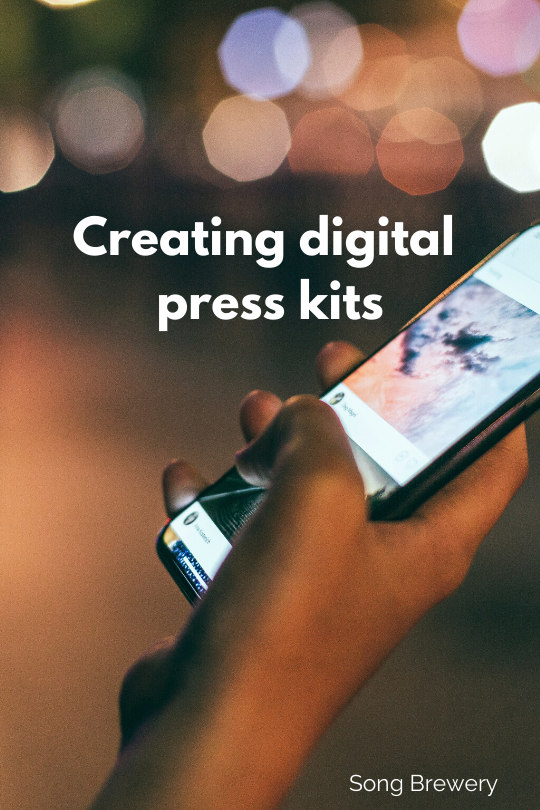The Musician Press Kit- what to include, how to set it up
Releasing music is probably among the most exciting adventures in an artist´s journey. Whether it is your first release or not, you will want to reach as many people as possible and hopefully gain new, loyal fans.
In order to get a decent amount of exposure, it is important to pitch your new releases to music blogs, magazines, radio stations, media outlets and other multipliers that will help you gain more reach.
In order for these professionals to take notice of your work, you need to be aware of certain pitch rules, that will increase the likelyhood of catching their interest. In today´s post, I would like to display how to set up a digital press kit, which is the ultimate must-have when pitching your music and news to the media.
To give you a short overview, these are the things to include into our digital press kit:
- Press Release
- Artist Bio
- Links to Social Media and Website
- High Res Images for DL
- Video for embedding
- Credits
- Contact Details
Let´s look into all these aspects more precisely:
How to write a press release
The press release is a key component of your press kit. It is somewhat comparable to the motivational letter in a job application. As with job applications, press releases also follow certain standard rules.
They usually include a catchy header, a subhead that lays out the most important pieces of information – usually answering the “W” questions (who, what, why, where).
Then the first paragraph should contain all relevant news in more depth. In the following paragraphs you can then add in extra information, such as background stories, quotes by the artist and maybe also pointing to some of your next appearances (important dates etc).
At the end of your press release should be a short general paragraph with an artist description and your full contact details (Name of Artist or representative, email, phone number, adress and web/social links).
Your press release should not exceed one page of copy. Remember that people are short on time and therefore will not be too intrigued to read several pages of copy to get to your core messages. They need the most relevant pieces of information quick and easy.
What to include in the Artist Bio
Your artist bio is an extra document designed to communicate your “Personal Branding”. The artist bio should be written in a third person perspective and should include a compelling story about what inspires the artist´s works and what kind of genre they work in.
The bio may include one or two personal quotes, but do make sure that these quotes catch interest.
Some basic information that need to be included are: Artist name, age (if you will), where the artist is residing and where they are from, what kind of genre they are in, when they started their career and the most important highlights/achievments so far as well as what makes their sound unique.
Make sure to include Social Media links and website links again!
Also, do include some high res images, at least 300 dpi, which are free to use.
If you need to credit the photographer, make sure to put their name underneath the images with a reference saying “courtesy to ______” (fill in name of photographer).
Using filesharing tools
In order to avoid spamming people´s inboxes with large attachments, make sure to provide a download link to your images. (I recommend you taking a look at our “Get Pitch Ready” post for tips on e-mail etiquette). You could use tools such as Dropbox, or your website to host the images and provide a download button.
You may also use WeTransfer, but be aware, that WeTransfer only hosts your files for a few days before they´ll be deleted.
If you have a music video to share, make sure to provide an embedding code for websites. The idea is to save people some work and providing them with all necessary links and codes they might need to craft a blog post or magazine article. That way they won´t have to research you on Youtube and other platforms themselves.
If you are sharing links to recent releases, make sure to use streaming links instead of attaching mp3 files. Do offer to send mp3s if required though.
Sharing exclusives easily
A lot of times, you will want to pitch your music before the actual release date, so blogs and magazines can be the first ones to publish your works!
In this case, you may make use of Soundcloud´s secret links, which allow for you to upload your music to Soundcloud and send the links to editors, but not other listeners. Your tracks will remain hidden to the general public and not pop up on your soundcloud profile. To send secret links, follow these instructions:
Upload your music to soundcloud and set link to “private” mode.
Go to the track and click on the share button that´s on the left (see screenshot).

There will be a “private sharable link” popping up.
You may send this one to the people of your choice via e-mail then. Only people that have access to this link, will be able to hear the track.
Questions?
I hope this overview helps you create a professional press kit! If you have questions or are insecure about your current press kits, feel free to drop us a comment or an email at office@song-brewery.com and we will get back to you with more tips!
Also, follow us on Instagram
Always happy to help!
Cheers, Katie



